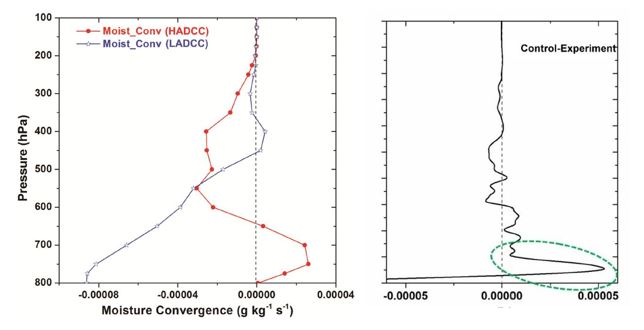Competing aerosol effects trigger convection over the Indo-Gangetic Plain
Submitter
Li, Zhanqing — University of Maryland
Area of Research
Cloud-Aerosol-Precipitation Interactions
Journal Reference
Manoj M, S Lee, and Z Li. 2021. "Competing aerosol effects in triggering deep convection over the Indian Region." 56(5-6), 10.1007/s00382-020-05561-3.
Science

Figure 1. Left: Moisture convergence for observed high-aerosol and low-aerosol deep convective cloud cases (HADCC and LADCC, respectively), showing enhanced moisture convergence in the planetary boundary layer for the HADCC case, leading to a moist, unstable atmosphere. Right: Difference in modeled moisture convergence between control and experiment runs, confirming observations. From journal.
Competing aerosol-induced thermodynamic and microphysical effects are examined using observational and modeling frameworks to characterize their relative roles in deep convection over the Indo-Gangetic Plain. This is an important science issue in the study of cloud-aerosol-precipitation interactions, especially in the highly populated Asian monsoon region.
Impact
Our study presents the novel result that aerosols over the heavily polluted Indo-Gangetic Plain, located within the Asian monsoon domain, not only stabilize the lower atmosphere but in a seemingly contradictory way also favor deep convection.
Summary
Deep convective clouds are an important component of the Asian monsoon. In recent years, aerosol effects on deep convection have garnered much attention. This study takes advantage of rich measurements collected during the U.S. Department of Energy Atmospheric Radiation Measurement user facility’s Ganges Valley Aerosol Experiment field campaign from June to September 2011, in addition to satellite retrievals and reanalysis data, to investigate how deep convection during the summer monsoon season is favored in a heavily polluted atmosphere such as that over the Indo-Gangetic Plain. Although a heavy loading of absorbing aerosols might stabilize the planetary boundary layer, weakening convection, observational analyses highlight the seminal role played by aerosols in increasing moist static energy, thus increasing the convective potential of the lower atmosphere. This leads to regional dynamical changes that trigger greater moisture feedback and regional precipitation. Computer simulations using the Advanced Research Weather Research and Forecasting model substantiate these observational findings.
Keep up with the Atmospheric Observer
Updates on ARM news, events, and opportunities delivered to your inbox
ARM User Profile
ARM welcomes users from all institutions and nations. A free ARM user account is needed to access ARM data.


















